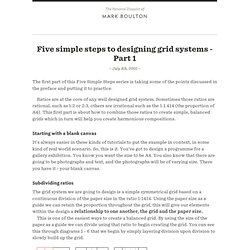

jack
Science Fiction Short Film Major. Concept Design. The Human Head. So we have been noticing a lot of work popping up on the forum for the competition!

One of the things we also noticed was that some of the “head sketches” showing off the product need a little love. I know first hand that people can be very intimidating to sketch! So here is a quick “how to getchyo head right” that I put together to give some guidance on sketching out a quick head for a product sketch. As the final sketches for the competition should be “presentation sketches,” you might think about having a human head somewhere on the page to show how the product lives. Step 1: Sketch (lightly and gesturally) a nice plump circle using your shoulder and arm. Step 2: Lets establish some more guides…Divide the circle again from the halfway line to the bottom with a horizontal line…and then again once more.
The Grid System. AisleOne - Graphic Design, Typography and Grid Systems. 6 Tips for Budding Designers to Earn While Building a Portfolio. Design is one of the more unusual industries to work in because it’s one of the few that often involves working for free, especially for those who are just starting out in a design career.

Working for free is starting to become more and more commonplace for those new to particular industries – as this article from The Guardian shows – but for designers, who actually create something, it doesn’t need to be this way. The dangers of spec work are well-known, and this post in particular does a brilliant job of explaining why it’s harmful. The premise is that a client offers money for designers to compete with each other. One designer gets paid, the other designers don’t.
It’s not fair, and it’s not rewarding. But when you’re just starting out in a career in design, you may be tempted to work for free in order to build your portfolio. My advice to you is this: don’t. How Can You Earn While Building a Portfolio? Of course, designing things for fictional companies won’t pay the bills. 1. 2. 3. A tutorial for good typography in InDesign - Setting up a baseline grid. Good clean typography is a fundemental skill of any designer.

Most designers believe they have good typography but in my experience it is something which is developed through time and experience. I think we all begin our design lives with a desire to be outrageously creative, and only as we mature, begin realise that simplicity and structure is just as, if not more important. In this article, I will go through some simple steps to acheive good clean well structured typography in Adobe Indesign. The first step is to choose your typefont. In this case I have chosen a simple standard font of Helvetica Neue. Lumn-grid poster design made neat and easy. A column grid system is a particularly useful tool for any designer wanting to create perfectly aligned typography.

It can be used in both print design projects and in your web designs, to help you achieve pixel-perfect website layouts. As Swiss graphic designer and teacher Josef Müller-Brockmann puts it: "The grid system is an aid, not a guarantee. " It permits a number of possible uses, and each designer can look for a solution appropriate to their personal style. But one must learn how to use the column grid; it is an art that requires practice.
As a general rule of thumb, the more columns you have, the greater the layout possibilities. In this tutorial I’ll show you how to set up a column grid structure the old-fashioned way. Software: Illustrator CS5 or later Project time: 30 mins (grid only) Skills: Understand the mathematics that’s involved in creating a column grid system, achieve perfectly aligned type, strengthen your typography skills Support file Step 01 Step 02 Step 03 Step 04. Five simple steps to designing grid systems - Part 1. – July 4th, 2005 – The first part of this Five Simple Steps series is taking some of the points discussed in the preface and putting it to practice.

Ratios are at the core of any well designed grid system. Sometimes those ratios are rational, such as 1:2 or 2:3, others are irrational such as the 1:1.414 (the proportion of A4). This first part is about how to combine those ratios to create simple, balanced grids which in turn will help you create harmonious compositions. Starting with a blank canvas It’s always easier in these kinds of tutorials to put the example in context, in some kind of real world scenario. Subdividing ratios. The Secret Law of Page Harmony.
“A method to produce the perfect book.”

The perfect book. This is how designer-genius Jan Tschichold described this system. Not the ok book, nor the pretty good book, but the perfect book. This method existed long before the computer, the printing press and even a defined measuring unit. No picas or points, no inches or millimeters. And you can still use it. The Secret Canon & Page Harmony Books were once a luxury only the richest could afford and would take months of work to be brought to fruition. And they were harmoniously beautiful.